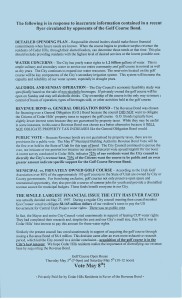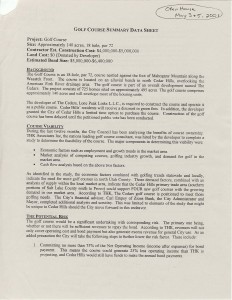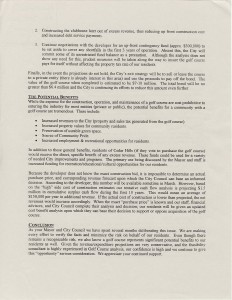Golf Course Options
by
Cedar Hills Councilman Rob Crawley
(Email Sent to City Council And Mayor 7/14/2015)
The Cedar Hills Golf Course is the single largest non-essential expense and most controversial issue that has ever faced the City. Further it is the cause of much of the discord that continues to permeate the city. We need to explore possible solutions
Therefore, after several years of researching the costs of the golf course and looking into ways to improve the profitability (individually as well as with the golf course finance committee), I would like to propose an alternative to continuing as is with the golf course. The golf course will continue to lose money at least until the bond is paid off in over 20 years and possibly indefinitely. Some have said that we have no option but to stay the course and continue to spend a large part of our city budget on the golf course. I believe there are always options. I have researched into many options and found all of them troubling individually, but I feel that a  combination of several different changes becomes a real option that may good for the city overall. Originally, the city residents did vote for the golf course. However, much of the information this decision was based on was inaccurate. I believe it is time for us to reassess the golf course as a city and decide if we want to continue as we have been, or whether to make a change. I am comparing two options.
combination of several different changes becomes a real option that may good for the city overall. Originally, the city residents did vote for the golf course. However, much of the information this decision was based on was inaccurate. I believe it is time for us to reassess the golf course as a city and decide if we want to continue as we have been, or whether to make a change. I am comparing two options.
Options for consideration:
Option 1 – Continue our same course of annual losses for 20 years until the bond is paid off.
Option 2 – Save money by turning the golf course into parks and other uses and pay off the bond.
Originally, the city residents did vote for the golf course. However, much of the information this decision was based on was inaccurate data; promising no cost to the taxpayers and profits of $1.5 million within 10 years (see attachments from 2001 golf course bond vote) Over the 10 years of operation, the average annual loss of $550,000 in taxpayer subsidies is the reality. I believe it is time for us to reassess the golf course as a city and have the residents decide if we want to continue as we have been or whether to make a change. I am comparing two options. The residents need to vote on this, as they originally voted for it (albeit based on false data). They should now vote on accurate, historical data.
Option 1:
The first is continuing to run the golf course with cash expenditures of between $300,000 and $800,000 per year for the next 20 plus years. As a point of reference, following are the historical subsidies (cash and debt amounts) paid per year on the golf course:
2004 $7,114,152
2005 $ 105,260
2006 $ (14,767) (Used leftover funds from original loan, paid down some debt)
2007 $ 448,741
2008 $ 848,418
2009 $ 591,176
2010 $ 429,747
2011 $ 348,196
2012 $2,631,780 (much of this is the building of the rec center/clubhouse)
2013 $ 786,541
2014 $ 358,886 (Total spent to date through 6/30/2014 is $13,648,130
2015 $ 400,000 (estimate)
2016 $ 800,000 (estimate, includes $300,000 for a golf maintenance shed)
(Note: The total cost through June 30, 2014 would be reduced to approximately $12.3 Million if we only include ½ of the cost of the rec center/clubhouse as in reality it is used about ½ for golf related activities and ½ for reception and city related activities)
Based upon this track record, I would estimate cash needs of approximately $500,000 per year for the next 20 years. The average cash needs per year have been approximately $550,000 per year for the last eight years (excluding 2012 spending on the rec center). Based on conversations with city employees, I believe that the number of regular golfers from our city is between 30 and 100. This means that we subsidize between $5,000 and $18,000 per regular user of the golf course yearly. I do understand that others benefit from the golf course and there are those that golf less regularly. I am currently researching the data to determine the actual number of regular golfers from our city.
Option 2:
Orem recently closed Cascade Golf Course and turned it into the new Palisade Park with soccer fields, etc. Salt Lake City polled its citizens and found that 75% preferred to have parks trails, open space, et., in contrast to only 6% who wanted to keep golf, —with 19% undecided. The Salt Lake City Council decided to close two of its golf courses in a cost savings effort and expand the use of the land to serve more citizens. (see link to newspaper report below)
- Refinance the golf bond debt with no strings attached to the golf course.
- Discontinue operations of the golf course at the end of the 2015 season.
- Sell enough of the land of the golf course to pay off the bond over the next few years. It is estimated that it would take selling less than 25% of the 115 acres of golf course property to pay off the bond. 50 of the acres of golf course currently are not maintained (i.e. 50 acres have native landscaping). Some of the acreage that would be sold and developed would be from the currently maintained area, some would be from unmaintained areas.
- For the homes that border the golf course, expand the property line several feet to give them increased value to compensate for any reduction in value that this change could cause to bordering homes. Include a fence paid for by the city for these same residents.
- Negotiate a new contract with either our current parks maintenance company or another company (based on bids) to maintain the golf course lands. The cost per year is estimated at $3,000 per acre and would probably cost approximately $150,000 per year. This is very comparable to the yearly operational losses of the golf course.
- Abandon the plans to develop the Harvey Park that has been on the budget to purchase for several years, but due to legal issues has not been purchased.
- Use the funds that we would have spent on the potential purchase of Harvey Park ($2 Million to $3 Million) to develop the golf course lands. There would need to be roads and parking lots to access the newly formed parks and there would need to be some land re-work to make some of the space usable as parks. The $2-$3M would only go so far. The city/residents would have to prioritize what the most important needs are (Parks/Soccer Fields/Baseball diamond, etc.).
- Continue to charge the funds for the bond to the residents to upgrade and develop more of the space each year until it is all beautified and developed into what is ideal for the city and then reduce the taxes to the residents for the amount of the yearly PI Bond payment.
For option #2, I believe we could get the debt paid off and only have costs of $150,000 per maintenance. I believe we would have several thousand of our residents using the different parks and venues that we could create per year. If we assume that 1,000 residents use these parks, the cost per year per user would be $150 per user compared to the $18,000 per regular user of the golf course.
Advantages of Option #2:
- Our losses from the golf course that we incur yearly would be stopped.
- We could create parks and recreation venues that our residents could ALL enjoy on a regular basis.
- Soccer and ball fields, additional trails, and picnic, etc., land would be available for resident use.
- We would be able to have the resources to do future projects that we currently can’t afford.
- The debate and arguments about the golf course would come to an end.
- The need for a grill at the city would go away.
- The need for proposed $300,000 golf maintenance shed would end.
- The arguments and debate about whether to serve alcohol to golfers would end.
Arguments Against Option #2 and Rebuttal:
1) “We have a legal obligation to keep the golf course open.” REBUTTAL: We do not have a legal obligation to keep the golf course open. Our development agreement was between the City of Cedar Hills and Lone Peak Links, the original developer. We fulfilled all of our obligations to Lone Peak Links in relation to the building of the golf course. As far as our obligation to others goes, we have no other contracts regarding the building and maintaining of a golf course. Nobody can expect an entity to lose $500,000 per year and continue doing so for many years to come and to commit to losses indefinitely is irresponsible to the residents.
2) “We have an ethical obligation to keep the course open for those that live in the Cedars.”
REBUTTAL: The City of Cedar Hills has gave a very valiant effort to make this work for the residents of the Cedars. After 12 years and $13.5 Million in expenditures, the City has done its due diligence to make this work. Those that live in the Cedars will benefit from wonderful soccer parks, baseball diamonds, and other green space options that they will be able to use at no cost. There is no legal liability from the city for those that live in the Cedars if we change from golf course green space to parks green space.
3) “Highland City will not allow us to change the area of the course in Highland City from golf course to parks.”
REBUTTAL: I have spoken about this to one of their city council people and he felt that there would be no problem at all making this change.
.
4) “The majority of residents want us to keep the golf course.”
Last year we did a survey for the city and one of the questions was “What would you do if you were mayor for one day.” The number 2 answer was shut down the golf course. The majority of the residents that I have talked to are tired of the losses of the golf course and would like to be freed from the burden so that we can do other things as a city. If Cedar Hills were to take a poll centered on the subject of the golf course, the results may be similar to Salt Lake City’s poll result of 75% preferring something other than golf for the land use.
5) “We will pay off the debt in about 20 years and then become profitable.”
REBUTTAL: The golf course industry is a declining business. As baby boomers age and are no longer able to golf, they are not being replaced by the younger crowd. This is a national trend. (See attached golf trend articles) For many years there have been more golf courses closing down than opening due to this trend. A recent study in Salt Lake City showed that of all the parks, trails and open space used in the Salt Lake City area, golf courses were utilized the least by residents. One of the questions posed to the city was “What would you do with repurposed Glendale Golf Course and Jordan River Par 3?”. Only 6% of those who responded wanted to keep the space as golf course. The golf course will not ever become profitable. Two problems the golf course has that will always keep it from becoming profitable are the other courses close by that are competition and the fact that we border a mountain that means we only have a 180 degree area to gain customers from. Additionally, our golf course has been characterized by players as difficult to play, hence not reaching the larger pool of potential golfers. If reconfiguration of the golf course to make it desirable to the average golfer were considered it could potentially cost taxpayers hundreds of thousands, in not millions more.
.
Conclusion:
The golf course industry is declining. We have lost $13.5 Million plus in this experiment thus far. We can convert the golf course to other usable green space that residents will use and appreciate much more than the golf course. Nobody can expect a city to continue to lose money on a project like this without seriously considering making changes, in fact it is negligent to continue down this path without looking into other options. There are obstacles in order to make the proposed changes, but I believe there are none that are insurmountable. When the residents of the city realize that we have a viable alternative to continuing as we are with the golf course, a large majority of the city will agree to a change. This same scenario has proven out in Salt Lake City recently. Let’s let the residents vote on this very important issue now that options and facts are now evident.
The Golf Course Finance Committee has been re-convened and we will meet this Thursday to begin researching and discussing options for the golf course. I don’t claim to have all the answers and I believe there is wisdom in numbers so I feel that this committee with the help of experts and residents can present the best possible alternative to the status quo. I present this as a rough draft to begin the serious conversations going forward. I hope to have two options on the ballet in 2016. Once the facts have been presented in an unbiased manner and two options voted on by the city (status quo vs the best possible alternative), I am prepared to support the voice of the people and to help to make sure that there is peace in our city regarding this issue.
Sincerely,
Rob Crawley/City Council
Supporting Documentation:
Link to Deseret News report on Salt Lake City Council’s golf poll and decision to close two golf courses
http://www.deseretnews.com/…/Salt-Lake-City-residents-prefe…
Link to articles discussing the decline of the golf industry
http://www.washingtonpost.com/…/why-america-fell-out-of-lo…/
http://www.forbes.com/…/how-a-declining-middle-class-is-ki…/
http://money.cnn.com/2014/08/07/investing/golf-sport/
Link to articles about Orem turning Cascade Golf Course into their new Palisade Park
http://www.heraldextra.com/…/article_11e027a2-d78e-5e4a-ad3… http://www.deseretnews.com/…/Orems-Cascade-Golf-Center-in-i…
____
[Attachments: The 2001 Mayor Brad Sears & City Council authored and promoted the flyers below used to encourage residents to vote in favor of buying Golf Course. Though successful in convincing 56% voter support, their information promising profitability, no alcohol or Sunday operation, no tax dollars to support golf course, etc., proved grossly inaccurate, misleading and costly to Cedar Hills taxpayers.]
[NOTE: Rob Crawley is a financial professional, currently employed as a CFO, having served as a CFO for other companies and as a CPA. ]
For the complete document above…


